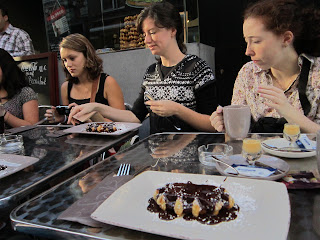On Sunday morning we climbed the 366 winding steps to the top of the Belfry and looked out at a Brugge shrouded in morning mist. I wrote my travel writing piece for this week on the Belfry, using third person and a historical angle. I'll include it in the bottom of this post. After admiring the view and listening to the bells chime, we climbed down glad that when we climbed up it was early enough that we didn't have to step aside for anyone coming down.
View from the Belfry and the Stairs
The rest of the day we spent relaxing. We took our lunch to a canal away from the tourist center of Brugge and enjoyed the peace and quiet, before our train ride home. (Below on the left Natalie and Melinda, my roomies. On the right the house with the most roof steps that we counted (25) steps are a sign of wealth, the more the richer).
The trains ran smoothly, we got on bus 83, the bus that should have deposited us back in Well. Here were are at the bus stop in Gennep where we were stranded for 1/2 and hr. The bus route to well was a different 83 (the bus driver drove that one too). He went on his half hour break and came back and drove the route to Well. So eventually bus 83 got us home, with stopover in Gennep.
(Above: August and Natalie rocking out to ipod music. Right: Melinda being awesome).
And now some higher quality writing. Yes I realize I spell Brugge differently in the piece. Brugge is how it's spelled in Brugge. Bruges is the American spelling and also the spelling used in the poem I quoted.
Belfry of Bruges
The words of Henry Wadsworth Longfellow still ring true today: “In the market-place of Bruges stands the belfry old and brown;/ Thrice consumed and thrice rebuilt, still it watches o’er the town.” Climb the stairs; spiraling up, they narrow as they near the top. The steps, though darkened with age, haven’t been there since the Belfry first stood looking over the market square. Wire grating encloses the top for the safety of tourists, indicating the tower now serves as an idle destination rather than the safeguard of the city. and the viewer looks out through the rectangle grid. Spread out in the morning mist below, brick houses with orange roof tiling line winding cobblestone streets, and the occasional canal wends through. Gothic church buildings and other towers of importance rise above the town. These buildings, impressive from the ground, shrink when viewed from the top of the Belfry tower.
Built in the 13th century, the Belfry served as a lookout tower. The bells warned of danger, announced a variety of important events. They rang a different sound for every message. Now the tourist climbs hears them ring the quarter hour. A symbol of the city both politically and economically, the Belfry tower housed Bruges’ important documents, and the halls below contained the flemish cloth market.
During the middle ages the Belfry watched over the most important trade center for the north-west of Europe. Merchants and guilds flourished, Grote Markt below bustled. Along with prosperity came revolts, as the divide between the merchants and the workman grew. Revolt broke out in 1280, the Belfry a casualty consumed in fire. The fire destroyed the city archives. Twice more the Belfry burned and each time they rebuilt it, a living emblem of the city’s vitality. For another century, trade, artisans, and guilds flourished in Bruges, then political instability saw the end of it and Bruges was left behind in the industrial revolution, Antwerp stealing the position of most important trade center.
Now in the scene below tourists fill the square. They gather around the statues of Jan Breydal and Pieter de Coninck, sitting down for a rest, to chat and eat a snack from one of the two booths below the tower. They have no idea they sit by men who led Bruges in victorious revolt against French rule. A line of people stands in the square, and it is unclear what they wait for until a horse and buggy clatters across the cobblestones, stopping in front of the line for new passengers. They wait to see the city by a more old fashioned method. The horse and buggies meld into the historic background of the city, with its carefully maintained medieval style houses. Down a winding off-street on the square, a group of American students sits enjoying waffles outside a small eatery. The proprietor’s brother-in-law complains about the lack of music concerts, while praising the cleanliness of Bruges. He explains that to paint the window—here he gestures to the large decals of a waffle, sandwich, and spaghetti adorning the glass—the design must be approved by the city. This management stands as testament to the tourism that has replaced lively trade as the sustenance of Bruges.


































